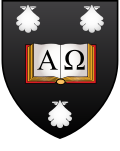Portal:University of Oxford
| Main page | Indices | Projects |
The University of Oxford portal
The University of Oxford is a collegiate research university in Oxford, England. There is evidence of teaching as early as 1096, making it the oldest university in the English-speaking world and the world's second-oldest university in continuous operation. It grew rapidly from 1167, when Henry II banned English students from attending the University of Paris. After disputes between students and Oxford townsfolk in 1209, some academics fled north-east to Cambridge where they established what became the University of Cambridge. The two English ancient universities share many common features and are jointly referred to as Oxbridge.
The University of Oxford is made up of thirty-nine semi-autonomous constituent colleges, four permanent private halls, and a range of academic departments which are organised into four divisions. Each college is a self-governing institution within the university, controlling its own membership and having its own internal structure and activities. All students are members of a college.
It does not have a main campus, but its buildings and facilities are scattered throughout the city centre. Undergraduate teaching at Oxford consists of lectures, small-group tutorials at the colleges and halls, seminars, laboratory work and occasionally further tutorials provided by the central university faculties and departments. Postgraduate teaching is provided in a predominantly centralised fashion.
Oxford operates the Ashmolean Museum, the world's oldest university museum; Oxford University Press, the largest university press in the world; and the largest academic library system nationwide. In the fiscal year ending 31 July 2023, the university had a total consolidated income of £2.92 billion, of which £789 million was from research grants and contracts.
Oxford has educated a wide range of notable alumni, including 30 prime ministers of the United Kingdom and many heads of state and government around the world. 73 Nobel Prize laureates, 4 Fields Medalists, and 6 Turing Award winners have matriculated, worked, or held visiting fellowships at the University of Oxford, while its alumni have won 160 Olympic medals. Oxford is the home of numerous scholarships, including the Rhodes Scholarship, one of the oldest international graduate scholarship programmes. (Full article...)
Selected article
The history of Brasenose College starts in 1509 when the college was founded on the site of Brasenose Hall by Richard Sutton and Bishop William Smyth. Its name is believed to derive from a bronze knocker (replica pictured) on the hall's door. The library and chapel were completed in the mid-seventeenth century, despite continuing financial problems. Under William Cleaver (Principal 1785–1809), the college began to be populated by gentlemen, its income doubled and academic success was considerable. New Quad was built between 1886 and 1911. Under Edward Hartopp Cradock Brasenose's academic record waned but it excelled at cricket and rowing; the reverse occurred under Charles Buller Heberden. Brasenose lost 115 men in the First World War and Lord Curzon's post-War reforms were successfully instituted. Sporting achievements again came at the cost of falling academic standards and finances. The 1970s saw the admission of women beginning in 1974, more post-graduate attendees and fewer domestic staff. Law and Philosophy, Politics and Economics were strong subjects under Principals Barry Nicholas and Herbert Hart) and the fellowship of Vernon Bogdanor. (Full article...)
Selected biography
Selected college or hall
Linacre College is a college for graduate students on St Cross Road, near the University Parks to the north-east of the city centre, and close to the university's science area. It was founded in 1962, originally as a non-residential and non-collegiate body called "Linacre House" to provide a base for graduates in Oxford. It moved to its present site in 1977, became financially independent of the university in 1980 and acquired full college status in 1986. The college is named after Thomas Linacre (1460–1524), a distinguished humanist, medical scientist and classicist. There are about 300 students in a range of subjects; many are from overseas, with over fifty different countries represented. Linacre was the first Oxford college to admit men and women on an equal basis. The principal is the botanist Nick Brown, appointed in 2009. There are about 50 Fellows, with former Fellows including the Nobel Prize winner Paul Nurse and the biologist Chris Dobson. Former students include the journalist Yasmin Alibhai-Brown, the literary critic Terry Eagleton and the Christian writer and academic Alister McGrath. (Full article...)
Selected image

Did you know
Articles from Wikipedia's "Did You Know" archives about the university and people associated with it:
- ... that John Weston (pictured) became a published poet after retiring from his post as Ambassador to the United Nations?
- ... that Ivor Bulmer-Thomas, having lost his position on the Historic Churches Preservation Trust (for which he denounced the Archbishop of Canterbury as having "held a pistol to my face while the Dean of Gloucester plunged his dagger into my back"), founded his own, more intransigent, committee, the Friends of Friendless Churches?
- ... that archaeologist Francis Turville-Petre, discoverer of Neanderthal remains in Israel, was portrayed in works by authors W. H. Auden and Christopher Isherwood?
- ... that the highly influential jurist Sir Matthew Hale once said that lawyers were "a barbarous set of people unfit for anything but their own trade"?
- ... that Richard Cordray, the first Director of the U.S. Consumer Financial Protection Bureau, is a five-time undefeated Jeopardy! champion and carried the Olympic Torch in 1996?
Selected quotation
Selected panorama
Wikimedia
The following Wikimedia Foundation sister projects provide more on this subject:
-
Commons
Free media repository -
Wikibooks
Free textbooks and manuals -
Wikidata
Free knowledge base -
Wikinews
Free-content news -
Wikiquote
Collection of quotations -
Wikisource
Free-content library -
Wikiversity
Free learning tools -
Wikivoyage
Free travel guide -
Wiktionary
Dictionary and thesaurus















